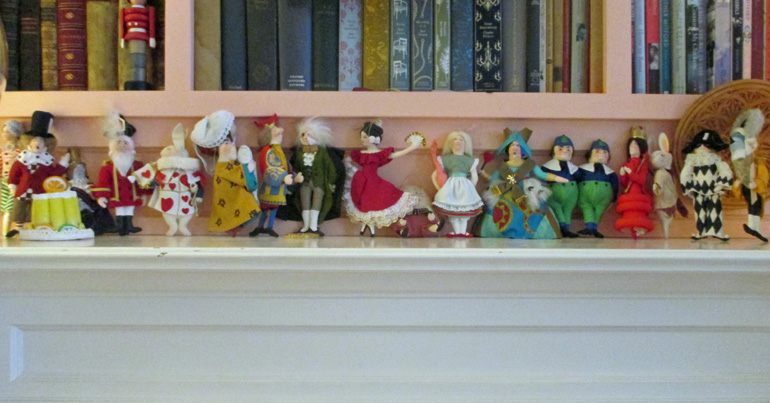Gotham Diary:
Pileup
December 2017 (III) Draft
Tuesday, December 26th, 2017
26 and 30 December 26
Tuesday 26
Merry Christmas! I may be a little late saying that here, but that’s because I was making sure that we would have one on time, which we did. I don’t know when I was last so active, day after day. There was very little time for reading, and none at all for thinking or writing. I’m still a bit blank.
But the rush is over. We’ve had all the dinners. We’ve been to Messiah at Carnegie Hall. We even took in Harry Clarke, David Cale’s brilliant dramatic monologue, brilliantly performed by Billy Crudup, down at the Vineyard Theatre. Harry Clarke ends with a terrific pair of one-liners, delivered in two of the protagonist’s three voices, and I wish I could quote them exactly. The show is about a gay man from South Bend, called Philip Brugglestein, who assumes a North London accent when he makes his way to New York City. Harry Clarke is a Cockney alter ego into whom Philip slips when under pressure. Whereas Philip is prim and hesitant, Harry swaggers like Michael Caine or Jason Statham. The transitions between personae are usually surprising and always entertaining, but the comedy of shifting identity becomes quite dark as the evidence of psychosis piles up. Mr Crudup sizzled with smiling danger. I hope never to meet anyone like the man whom he was impersonating.
At Carnegie Hall, Kent Tritle led Musica Sacra in his austerely beautiful interpretation of Handel’s Messiah. It was at least the third time that we’ve made a point of decking out our holiday with this event, and I am finally persuaded that a smaller Messiah is not necessarily a lesser one. Stripped of posthumous ornamentation by Mozart or anyone else, the oratorio emerges as an urgent vocal meditation. The light string band — a dozen violins, three violas, and a bass consisting of cello, doublebass and bassoon, with sparingly-used pairs of oboes and trumpets (and drums at the very end) — provides the solos with unobtrusively defining harmonies and then almost disappears into a wash during the choruses. The chorus of thirty produced the sound of sixty with complete precision. Once again, Kathryn Lewek sang the soprano airs with beauty, accuracy and grace to match the chorus. It’s gratifying to see her name in the program and to think, I know that this evening’s soprano is going to hit all the high notes with impassioned charm.
Most nights, during the week, I knocked off Michael Prestwich’s Edward I. I found myself wishing for a more overtly economic analysis of Edward’s catastrophic money troubles. (The catastrophe eventually befell his son, Edward II.) Edward was not a spendthrift, but he was often at war, almost uninterruptedly so from 1294 to his death in 1307. Military operations appear to have become considerably more expensive during his reign, which began in 1272. Some of the increase was attributable to the final stages of a shift from feudal dues to money salaries, but armies also became larger, and their arms and armaments more powerful. There was no English precedent for the great and very expensive castles that Edward built in North Wales; the last of them, Beaumaris, was never finished. In the background of Prestwich’s biography, royal bureaucracy and the judiciary seem to become more institutional and professional, and commerce, especially the wool trade, grows more prosperous. And of course Parliament begins to assume a representative complexion. But for all the adumbration of modern government, Edward’s England is unquestionably medieval in character. The king was well-liked by his people, but his incessant exactions were understandably unwelcome; most of all, they suggest a misconception of needs and resources. The overall sense is one of backing into the future.
***
Saturday 30th
Not long after I began noticing them in The New Yorker, I learned not to read Alice Munro’s short stories. I found them terribly bleak. Everything about them was plain, or worse. The people were dull and discontent. They lived in drafty old farmhouses or airless suburban cottages. Love was apparently the subject, but I could not conceive of love, especially in its joyous aspect (which meant more to me than any other), amidst such repressive circumstances. The stories were set, for the most part, in rural Ontario, a territory that I had no desire to imagine, much less visit. My time in South Bend and Houston had replaced my childhood ignorance of country life with adult aversion; it seemed inhuman to me to persist in inhabiting such places. It still does.
But I have learned better about Alice Munro. I have been reading her collections since the beginning of this winter, and my delight is teaching me even more. Yesterday, while I was anxiously wondering when I would ever hear from Kathleen — she was flying home from a visit to her father in North Carolina — something clicked. I was in the middle of “Monsieur les Deux Chapeaux” (collected in The Progress of Love) when I grasped something about Munro’s fictional background. Just as Leonardo’s figures hover in misty, rocky landscapes, and Gainsborough’s take their ease in green parks, Munro’s characters slog past and away from confusion about the past. It is the same in story after story, and the cause of my old discomfort with her work. It is the illusion of an old world that is slipping into oblivion, a vanishing way of life that cannot, especially for heroines, vanish fast enough. It is an illusion because that old world is actually dying very young. It did not exist a century earlier; fifty years before that, even the people weren’t around.
The moment that illuminated this for me yesterday is almost too densely buried in the context of Munro’s story to extract without belaboring it; I hope that it’s enough to say that it involves the termination of passenger railroad service to the town in which the story takes place, about ten or fifteen years earlier. The most important consequence of this development for the brothers at the center of the story is the loss of their father. A conductor on the passenger trains — does this term, “conductor,” mean anything to younger readers? — the father was transferred to another town, from which he could visit his family by bus, which however he disliked doing. He couldn’t drive, either, and so his visits home ceased, and he died before retiring, so his widow is free to speculate that he might have returned to her eventually.
So the train is gone with the wind, and, with it, the network that bound every town of decent size to the nation at large. From now on, country people would have to spin their own webs, as their personal resources allowed. Some would have cars. Eventually, everyone would have a car, but most of Munro’s protagonists can remember not being able to afford one. Her most characteristic narrator is a woman who grew up on a farm before World War II. Sometimes, the farm might be close to enough to town to walk to, but an aspect of the illusion of Munro’s background is that Ontario is so vast that family members are prevented by distance alone from coming together for decades at a time. A cousin pays a rare visit — once — and the chore of putting up new wallpaper in the visitor’s bedroom is what really lodges in the memory. The reader may begin to imagine that the railroads, however empowering and impressive when they were built, came to be regarded as the enablers of intrusion and desertion. There is something about Munro’s towns that can’t grow, or can’t outgrow the frontier provisionality that has long since gone stale. All the boldness required for settling the province seems to have been exhausted in the opening moves; the settlers’ children exhibit the same grim tenacity that would have kept their forebears in the old country. And now, in the present moment of Munro’s fiction, nobody can remember how or why they came to be there.
At the heart of the illusion is a kind of timelessness: the farmers whose daughters long to go to university in Toronto are scions of families that never left Scotland or Ireland or Norway. For Munro’s older Ontarians, this illusion is a delusion, a response to the shock of transatlantic relocation. For several decades in the Nineteenth Century — European peasants were given an amazing new option, a grab at freedom and prosperity in North America. Steamships and railways carried them far into the new land. Then, just as quickly, the steamships and railways themselves became obsolete, replaced by cars and planes, modes of transportation that erase the middle distance. Exciting novelties became outdated clichés — in the space of a generation. The former peasants had to learn that freedom and prosperity would mean something very different to their children, especially to their daughters. The farmers would be betrayed by their dreams. But their children, Munro’s characters, would be mesmerized by the illusion of throwing off the yoke of centuries of servitude.
I am aware that the foregoing is riddled with contradictions; Munro’s ability to blend them plausibly is what gives her stories such atmospheric power. It is this atmosphere that her characters seem to be fighting the hardest. There is the desire of the settlers’ grandchildren to believe that their people have always lived in Ontario, as if since the expulsion from Eden; at the same time, these grandchildren are oppressed by the peasants’ conservatism and limited horizons that survived the transplantation intact — that, indeed, may have been intensified by it. The prospect of upward mobility is shadowed by the possibility of total loss. Tradition, as always, is both reassuring and restrictive. And the ongoing social and technological changes that were unleashed by the revolutions that closed the Eighteenth Century pile up ever higher behind the up-to-date instant, belying their actual age, their altogether recent vintage.
How can our understanding possibly keep up?
Bon week-end à tous! Happy 2018!



